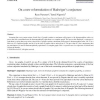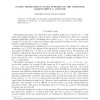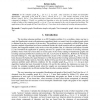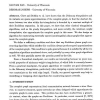JGT
2008
13 years 4 months ago
2008
We consider the following question: how large does n have to be to guarantee that in any two-colouring of the edges of the complete graph Kn,n there is a monochromatic Kk,k? In th...
DM
2006
13 years 4 months ago
2006
Assuming that every proper minor closed class of graphs contains a maximum with respect to the homomorphism order, we prove that such a maximum must be homomorphically equivalent ...
DM
2008
13 years 5 months ago
2008
In this paper, we prove that cyclic hamiltonian cycle systems of the complete graph minus a 1-factor, Kn - I, exist if and only if n 2, 4( mod 8) and n = 2p with p
DM
2008
13 years 5 months ago
2008
For two graphs G and H, let the mixed anti-Ramsey numbers, maxR(n; G, H), (minR(n; G, H)) be the maximum (minimum) number of colors used in an edge-coloring of a complete graph wi...
DISOPT
2010
13 years 5 months ago
2010
We consider labeled Traveling Salesman Problems, defined upon a complete graph of n vertices with colored edges. The objective is to find a tour of maximum or minimum number of co...
CORR
2010
Springer
13 years 5 months ago
2010
Springer
We present a detailed study about the role of the short-cuts of a network in promoting the emergence of cooperation in a population of agents playing the Prisoner's Dilemma Ga...
ALGORITHMICA
2010
13 years 5 months ago
2010
We study the merging process when Kruskal's algorithm is run with random graphs as inputs. Our aim is to analyze this process when the underlying graph is the complete graph ...
FCS
2006
13 years 6 months ago
2006
: In the complete graph K2m+3 for m 2, we study some structures of simple non-isomorphic Hamiltonian sub-graphs of the form H ( 2m+3 , 6m+3) for m 2 . The various structures of t...
OA
1989
13 years 9 months ago
1989
nce Abstract) 1 GAUTAM DAS - University of Wisconsin DEBORAH JOSEPH - University of Wisconsin Chew and Dobkin et. al. have shown that the Delaunay triangulation and its variants ar...
STOC
2005
ACM
14 years 5 months ago
2005
ACM
We introduce a new graph parameter, called the Grothendieck constant of a graph G = (V, E), which is defined as the least constant K such that for every A : E R, sup f:V S|V |-1 ...




